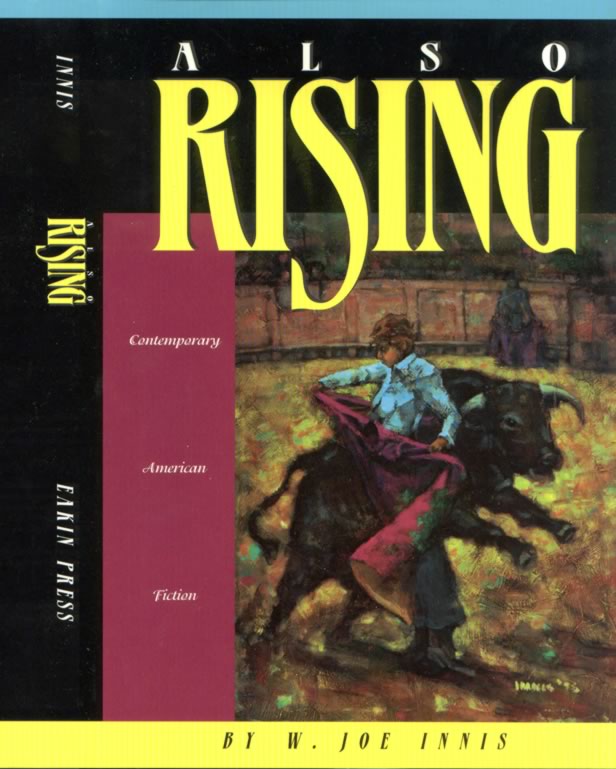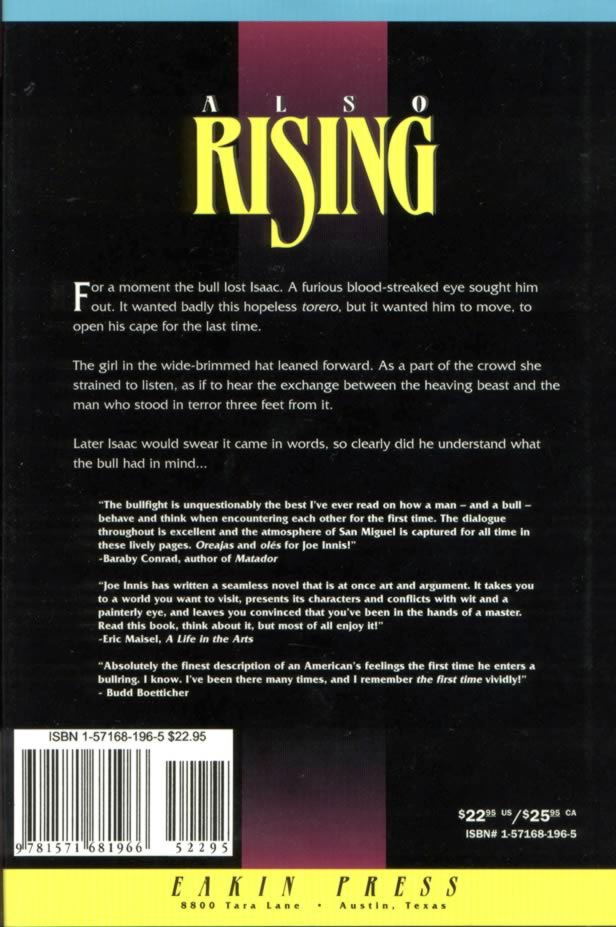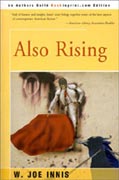It's
the Vietnam era, and Isaac, a hopeless romantic, has found a job teaching
sculpture in an American art colony in Mexico when he falls in love
with the willowy girlfriend of a visiting celebrity artist. A cunning
bull rancher manipulates the two into facing each other in a highly
unconventional bullfight.
In the crowd was the girl in a wide-brimmed hat. She leaned forward as though to listen, as if to hear the exchange between the heaving beast and the man who stood in terror three feet from it ... |
A L S O
RISING

Contemporary American Fiction
By W. Joe Innis
From Gale's Contemporary Authors:
"Innis pays homage to Ernest Hemingway, author of the classic novel The Sun Also Rises, with his own Also Rising. Like Hemingway, Innis focuses on an expatriate's encounter with the world of bullfighting. Also Rising is set during the Vietnam era, and features a disillusioned artist named Isaac Sherderval, who escapes his life in the United States and takes a job teaching art in Mexico. There he meets Heinrich Guerber, an influential painter. Attracted to Guerber's fiancée and nettled by the more successful artist's arrogance, Sherderval is drawn into a plot that pits him not only against Guerber, but against a fighting bull..."


From ALA Booklist:
"It is the Vietnam era, and Isaac, a painter, has found a job teaching sculpture at an American art colony in central Mexico. After a long dry spell, his life is looking up, and he is experiencing a wonderful creative flow. Trouble comes in the form of Heinrich: an egotistical and powerfully successful New York postexpressionist who has made a career out of painting stripes over other artists' masterpieces. The antipathy between the two comes to a head at a party when Isaac, in trying to describe the artistry at the heart of bullfighting (which Heinrich has been demeaning), is maneuvered into accepting an invitation to demonstrate his skills the next weekend. Even if he can survive the contest, he will have to deal with an enemy with the power to destroy his career. Full of humor and insight, Innis' story brings together some of the best aspects of contemporary American fiction in its exploration of what it means to find art in life, and life in art."
From Publishers Weekly:
"A Beautiful woman, two courageous matadors, and a brave bull. Mano-a-mano. Think of the weighty implications." A pivotal bullfight resolves the romantic triangle in Innis's unabashedly Papa-esque second novel (after In Pursuit of the Awa Maru), which channels Hemingway's machismo through the life of a disaffected expatriate artist in the 1970s. Isaac Shelderval is a casualty of Warholian postmodernism, a traditional painter who elects to teach in the small town of San Miguel, Mexico, after his work becomes unsalable and his wife leaves him to pursue her career as a pop singer. The school changes Isaac's initial plans by placing him in charge of the sculpture department. His peace of mind is further disturbed by guest artist and lecturer Heinrich Guerber, who arrives with his stunning girlfriend, Memori, in tow. Isaac soon finds himself competing with Heinrich for Memori's attention when a local bull breeder arranges to teach both artists the rudiments of bullfighting . The chapters preceding the climactic bullfight are slowed by Isaac's relentlessly jaded perspective, but Innis explores a variety of issues, including the possibility of mixing love and art, as the romantic triangle comes to a point. His balanced yet stirring description of the bullfight becomes the subtext for his sensitive depiction of the life of a dedicated artist."
From Kirkus Reviews:
" . . .postmodern backward glance at Hemingwayesque bullfighting ethos, recast as a macho conflict between artists in southern Mexico. First-novelist/Artist's Magazine columnist Innis can't help but feel sorry for Isaac Sherderval, a struggling Impressionist painter who, in 1970, takes a teaching gig at an American art school in southern Mexico in order to forget his failed marriage- -as well as his forgettable songwriting day job. But what begins as a quaint, American-in-paradox, fish-out-of-water tale in the scenic if sorry town of San Miguel de Allende soon becomes a mano a mano contest between Sherderval and Heinrich Guerber, a German-born pop artist who's achieved wealth and notoriety among the New York art crowd by painting over works by well-known French and American Impressionists. Guerber, who's making a triumphal return to his alma mater, tells Sherderval that he finds only cruelty and barbarity in bullfighting--whereupon Sherderval counters by praising it as a solemn, vital cultural ritual that resonates with his own artistic endeavors. The two agree to try the cape before inexperienced bulls at a nearby ranch, with the prize being Guerber's slender, model-beautiful girlfriend Memori. In a brilliantly executed scene, Guerber suffers an easy success but lacks the courage to go up against a formidable beast. And Sherderval embarrasses, then redeems himself, not through courage, but through a series of accidents that inadvertently express his romantic indifference to danger. Sherderval's fling with Memori and Innis's message--that artists need unequal portions of solitude, historical tradition, and appreciation--are forgotten when sore-losing Guerber falsely accuses Sherderval of harboring drugs. Sherderval flees with his windy artist friend Sturgeon Boswell, who prattles on about what is or isn't good for artists and saves Sherderval from a fate worse than marriage. Amusing, pretentiously anti-pretentious, portrait of the artist as an earnest schlemiel, leavened with an ironic, Hemingwayesque admiration of its south-of-the-border setting."
From THE DALLAS MORNING NEWS (Sunday Reader)
Artists Excel In Running Of The Bull By Clay Reynolds
Not too long ago, a novel as sensitively written as this would not have aroused much notice among readers. But these days, with large commercial publishing companies turning away from any story that doesn't have a strong female protagonist, six or seven erotic scenes and the usual complement of Uzis and car chases to make it marketable, finding a book that aspires to be literarily artistic is a rarity.
At first blush, the story here is familiar, and so is the situation. Isaac Sherederval, artist, sometime song lyricist, sometime journalist, arrives in San Miguel, about six hours by train from Mexico City. Remote and somewhat primitive, the hamlet is the home of a large art colony of American students and tourists, all come to Mexico to discover their talents.
A painter, Isaac is subjected to the myopic confusion of the school's chief administrator, Bill Spencer. Spencer has no recollection of hiring Isaac or of needing a painting instructor. He has, however, just lost a teacher of sculpting, so Isaac is set to work instructing those classes.
The first third of the novel, roughly, is involved with Isaac's period of adjustment to conservative Mexican mores and to a typically American academy, where no one cares who is teaching the classes so long as the enrollment is up.
Deliberately reminiscent of Hemingway's Jacob Barnes right down to the "wound" - he is fleeing a bad marriage and is without much money - Isaac's background is sketchily presented. He apparently has lived on both coasts, as well as in border towns.
Into this pastoral comes Heinrich Geurber, famed German artist, late of New York's SoHo district. An admirer of Warhol, Heinrich is a self-styled iconoclast and egocentric, bent on destroying the traditional forms even if he has to rip them up or paint his own work over them. For this, he has been handsomely rewarded by America's art establishment.
Not surprisingly, the idealism of the two men clashes, a conflict heightened by Heinrich's beautiful companion, Memori, a flirtatious dancer with whom Isaac is instantly smitten.
Tensions rise over the issue of bullfighting. Heinrich takes the "humanist" line that such blood sport is barbaric and cruel. Isaac, sensitive to the importance of understanding the traditions and meanings of other cultures, defends it. The result is that a bull rancher arranges for the two men to attend a tienta, a largely ceremonial event in which young fighting bulls are evaluated by amateur matadors. Isaac and Heinrich both face the bulls, and in a wonderful, comic scene, the deeper meaning of the corrida and the mysticism of the sport causes both men to confront their own characters and inner strengths.
Echoes of The Sun Also Rises are unavoidable, even if the title doesn't give it away. Apart from the Jake‑Isaac locus, Heinrich recalls Robert Cohn, and the alluring but fickle Memori is a delicate homage to the sometimes brutal Lady Brett. There's even a picnic scene next to a ruin. Fortunately, however, Mr. Innis stops short of imitating the famous Hemingway style, or of paralleling the story completely. . .
Finely drawn with a cunning display of detail and internal emotional conflicts, this bittersweet tale of art, expatriation, courage and love in the Mexican afternoon sun flows smoothly and reveals much of the inner nature of human courage, love and ambition. Eakin Press is to be commended for bringing the work of this intriguing writer to Texas' readers' attention. -Novelist Clay Reynolds lives in Denton. -KEYS- BOOK REVIEW


“.
. . (Also Rising) is so rich with wit and art, argument and philosophy,
slap-stick and tragedy. . . This book would make a terrific film.”
— Duncan
Regehr, artist
and actor
“Absolutely
the finest description of an American's feelings the first time
he enters a bullring. I know. I've been there many times, and I remember
the first time vividly!”
— Budd
Boetticher, Hollywood
director
“Joe
Innis has written a seamless novel that is at once art and argument.
It takes you to a world you want to visit. It presents its characters
and conflicts with wit and a painterly eye, and leaves you convinced
that you've been in the hands of a master . . .”
— Eric
Maisel, A Life in
the Arts
“The
bullfight is unquestionably the best I've ever read on how a man - and
a bull - behave and think when encountering each other for the first
time. The dialogue throughout is excellent and the atmosphere of San
Miguel is captured for all times in these lively pages. Oreajas and Olés for Joe Innis!”
— Barnaby Conrad, best-selling author and artist
“As
a professor of literature and an aficionado of the corrida . . . it
was a delight to read a book that satisfies both those passions”
— Joe Distler
“ALSO
RISING, is not a novel about bullfighting, per se, and what Mr.
Innis writes about bullfighting is done in such an original way that
it is everything but a cliche. It is a novel that deals with human nature,
with the conflict between good and bad, personified by an honest painter
and a fake one, respectively, with the concept of plastic art, including
bullfighting, and with the clash of American and Mexican cultures.”
—Mario
Carrion
writer, bullfighter


